A coastal P-change for the Price family
The Price family have implemented phosphorus supplementation and fertiliser, pasture improvement, vaccination, parasite management, control mating and objective bull selection on Greenlake Station, Rossmoya.
The Price family purchased Greenlake Station north of Rockhampton in 2021, to complement their Arcardia Valley properties Hillyvale, Tarcoola and Korcha. In 2024 the purchase of Iwona expanded their operation again. Greenlake plays an integral role in the Price Cattle Company business by producing weaners for the western properties. Over the last four years, the Price family have been learning how to fine-tune the management of coastal country to maximise its productivity and profitability. In this two-part story, read about the early days on Greenlake – starting to supplement with phosphorus, herd health and breeding management, through to 2025 with pasture development.
Part 1 – Early days of Greenlake, September 2022
With challenges come opportunities
Breeder management to suit conditions
Ticking the boxes with paddock rotation
Part 2 – Life on Greenlake, August 2025
The goal is the same but planning is flexible
A double barrelled phosphorus approach – supplement and fertiliser
Local networks and sharing with others
Part 1 – Early days of Greenlake
September 2022 with Owen Price
With challenges come opportunities
“Our family has been in the Arcardia Valley for 59 years. We run an organic breeding, growing and fattening enterprise across our three properties,” said Owen Price. “We were looking for some more country to continue business expansion and Greenlake really caught our eye. The country is green for most of the year and has lots of water. We knew that coastal country would have its own management challenges, but we saw opportunities to further develop the country and increase its pasture production and cattle turn off.”
Greenlake is a 7,675 ha property dominated by land types common to the central Queensland coast including; Blue gum/river gum flats, Coastal tea tree plains, Coastal eucalypt forests and woodlands and Loamy alluvials. Coastal country is widely known to be low in phosphorus (P) and traditionally the large property had been run as a year-round mated herd producing weaners for the local store market. The district has an annual average rainfall over 1,000mm.
“Our plan is for Greenlake to supply weaners to our properties in the Valley and produce more feeder cattle from our whole operation. Our priorities for the first 12 months at Greenlake were to implement P supplementation, vaccination and health treatments, move towards controlled mating, and purchase some new bulls,” said Owen.
The Price family started at Greenlake with 1,700 Brahman cross females and 60 bulls. P supplementation was first on the agenda, in fact, lick troughs and a P lick were ordered before the property officially changed hands. The first 10 tonne of lick arrived the day they took over.
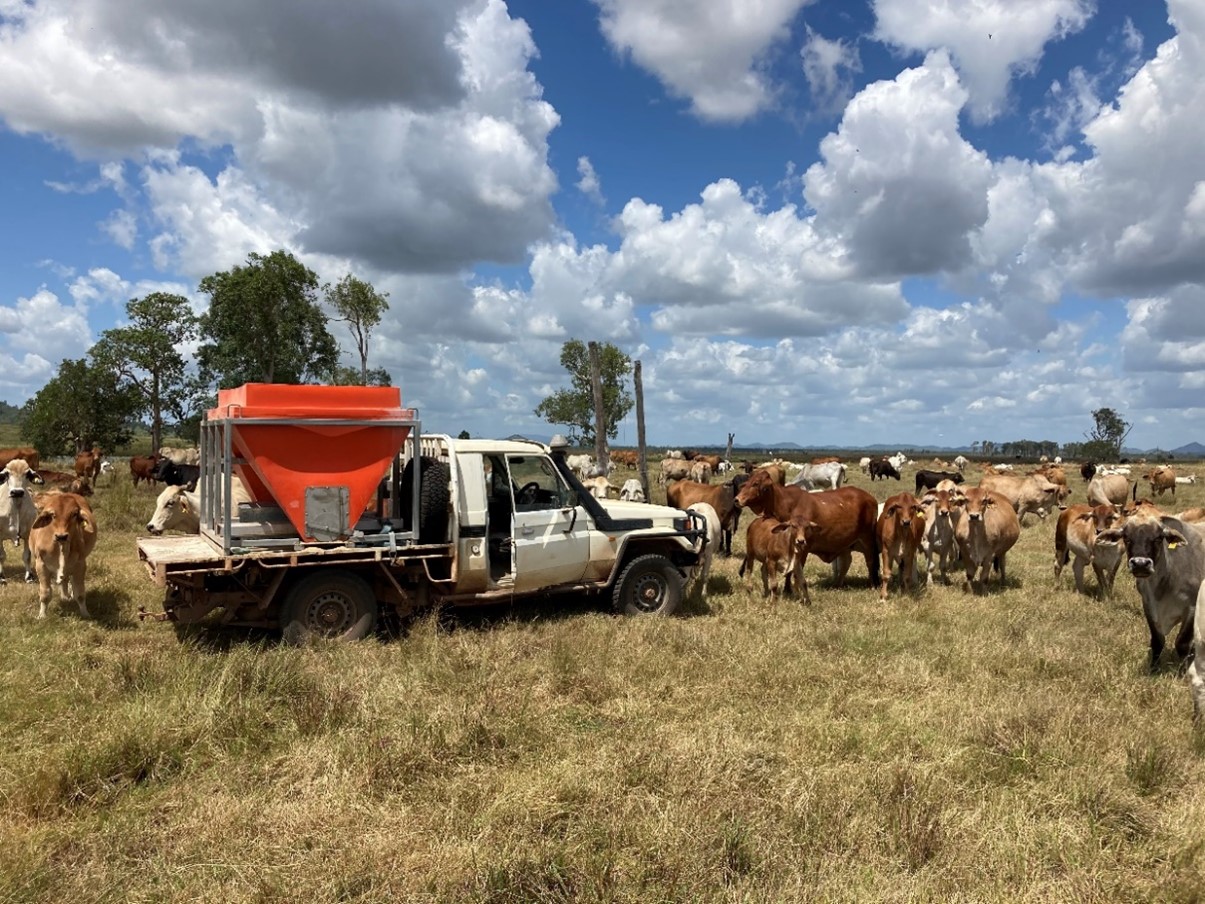
Fine-tuning the lick intake
“We knew we had to feed P, so approached FeedPro at Gracemere and asked for a P mix. The starting mix was 9% P, 12% calcium and 5% salt. It also contained rumensin. We found that the consumption was quite good, but after we got through that first batch, the consumption dropped right off. We knew the cows weren’t getting enough P but weren’t sure how to tweak the mix. I knew DAF helped people will cattle nutrition, so I gave Kylie in the Rocky office a ring.”
“P supplementation can be tricky,” said Kylie. “The aim is to get the required amount of P into cattle in the most cost-effective way. Most cattle will not eat a P source on its own, so we add an attractant to the mix – usually salt or protein meal. We generally find that salt doesn’t work as well for coastal cattle, so I suggested to Owen that the salt be dropped out and protein meal included instead. The extra calcium and rumensin were also not needed for this country.”
Based on discussions and calculations with Kylie, the next Greenlake mix contained 11% P with protein meal, no salt and less calcium. Kylie explained “We needed this mix to be quite palatable because on the P deficient country we were aiming for cows to eat approximately 10 g of P per day. With this mix, cows would need to eat 90 g of supplement per day.”
Owen said that they also experimented with protein meals to find what their cattle would eat most readily. The final supplement mix contained cottonseed and canola meal. The P source is both Kynofos and DCP.
“Over the first few months of 2022, the cow/calf units on the more deficient country were eating 20 g of P per day. We thought this might be a bit high but talking with Kylie, we think it’s about right,” said Owen. “The weaners we pulled off those cows averaged 220 kg and growing, so they would need a lot of P too.”
Kylie commented, “A 400 kg lactating cow on deficient country needs 9-10 g of P per day. Add in a 200 kg weaner growing at about 0.9 kg per day that needs 9 g of P, and we are not too far off the mark with the current consumption of 20 g of P per day.”
Owen commented on how accommodating FeedPro had been with developing the new mixes. “I’m very grateful to be doing business with a company who was happy to work with me to create a product that suits my cattle.”
The results of the P supplementation program can easily be seen in the cattle – body condition score and weaning rates are very good.
“We have a 73% weaning rate and the cows weaned in May 2022 are body condition score 4. We are really happy with the results of the P supplementation program,” said Owen.
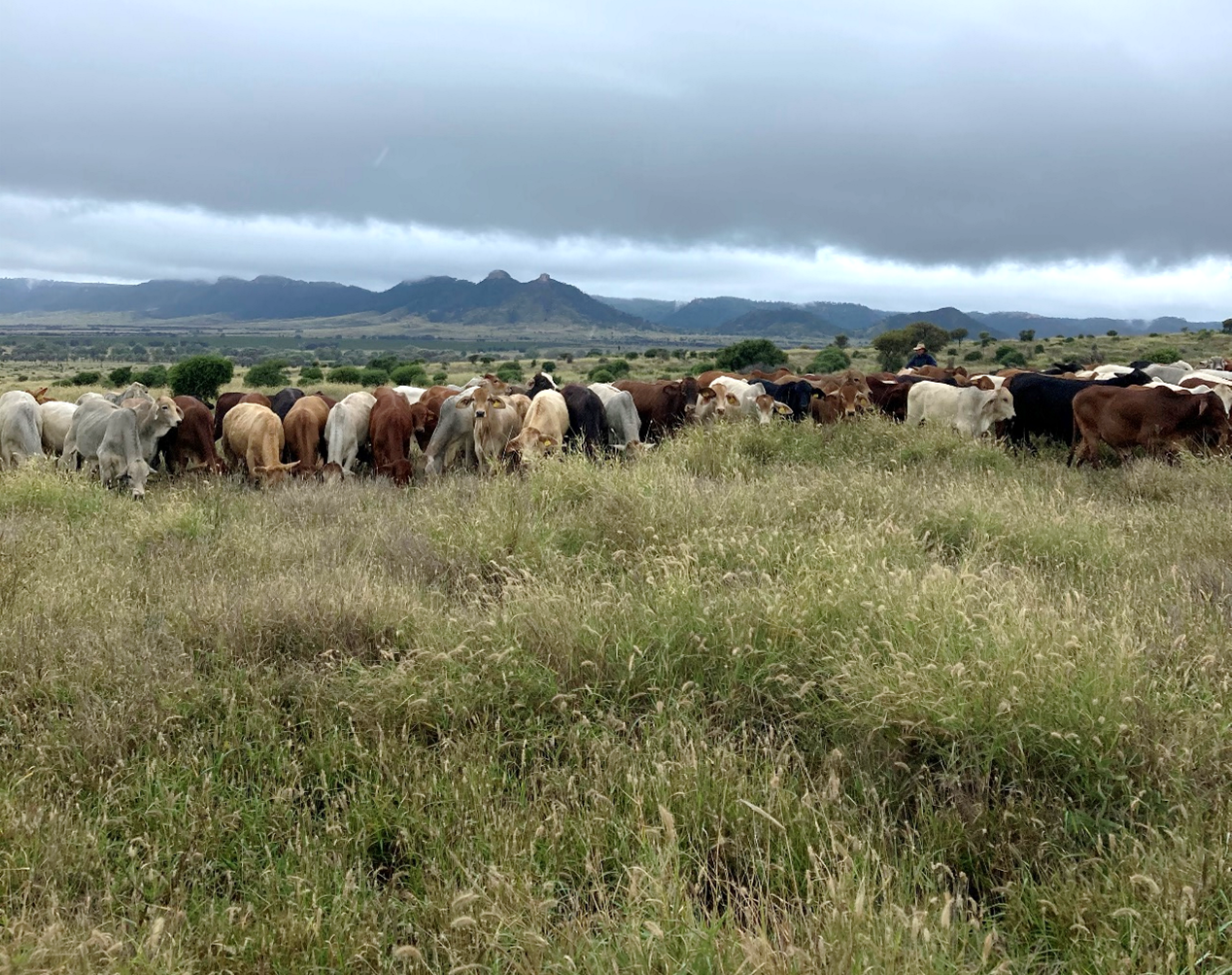
Breeder management to suit conditions
Although feeding a P lick was first on the agenda at Greenlake, the Price family had plans for the breeder herd too. One month after the first P was fed, the whole property was mustered. All cows that were dry and empty were sold, along with about half of the bulls which were culled for age. The remaining bulls were taken out from the cows in preparation for a September joining. All cows were vaccinated for 7 in 1 and botulism, and treated with Acatak™ for ticks. Belmont Red bulls were purchased for the 2021 joining season.
“We selected 22 Belmont Red bulls based on EBV data. We were looking for bulls with negative days to calving and positive growth EBVs. Our plan is to gradually move towards a control mated herd, so we put bulls out September 2021 to February 2022. The older bulls with one mob of cows and the new bulls with another mob. Next year we will cull some more of the original cows as we have replacement heifers coming through and we will tighten the joining a little more, probably take the bulls out in late January,” said Owen.
Moving from a continuous mated herd to a control mated herd has its challenges that the Price family have considered.
“We have to manage the size of the breeder herd, weaning dates, number of replacement females, amongst other things. Some cows might take a season or two to fall into line, and some won’t at all. We will select for fertility and growth. The goal is to have a Belmont Red x Indicus female herd that is yearling mated and produces consistent weaners in a three month joining period, that we can background on our properties in the Arcadia Valley. We want a line of females that are adapted to this country with early puberty and higher inherent fertility. That is what we will be selecting for.”
Calving time is also an important element of the breeding plan.
“The risk of flooding here on our lower country has made us think about how we manage the herd at different times of the year. In the right conditions we can get a flood at any time of the year. We’ve been here less than 12 months and we’ve already had water on the flood plain in November, April and May!”
Best practice in most areas of Central Queensland is for joining to be planned so that cows calve about 6-8 weeks before the Green Date. In this region, the Green Date is defined as the date when there is a 70% chance of 50 mm of rain over three days. This means that cows aren’t lactating for too long before there is good probability of having green feed.
Flood country however, can be a challenge, explains Kylie.
“As there is green grass most of the year, the timing of the seasonal break is less critical. What is more important is when the country is likely to flood. From a welfare perspective, you don’t want cows calving in flood season as both cows and calves can be lost.”
As a result, the Price family have planned the 2023 calving for winter, to avoid the flood season.
“We are moving towards a September to December joining period. This will produce a June to September calving when there is less chance of flooding. We expect that it might take about five years to get there, but that’s what we’re aiming for,” said Owen.
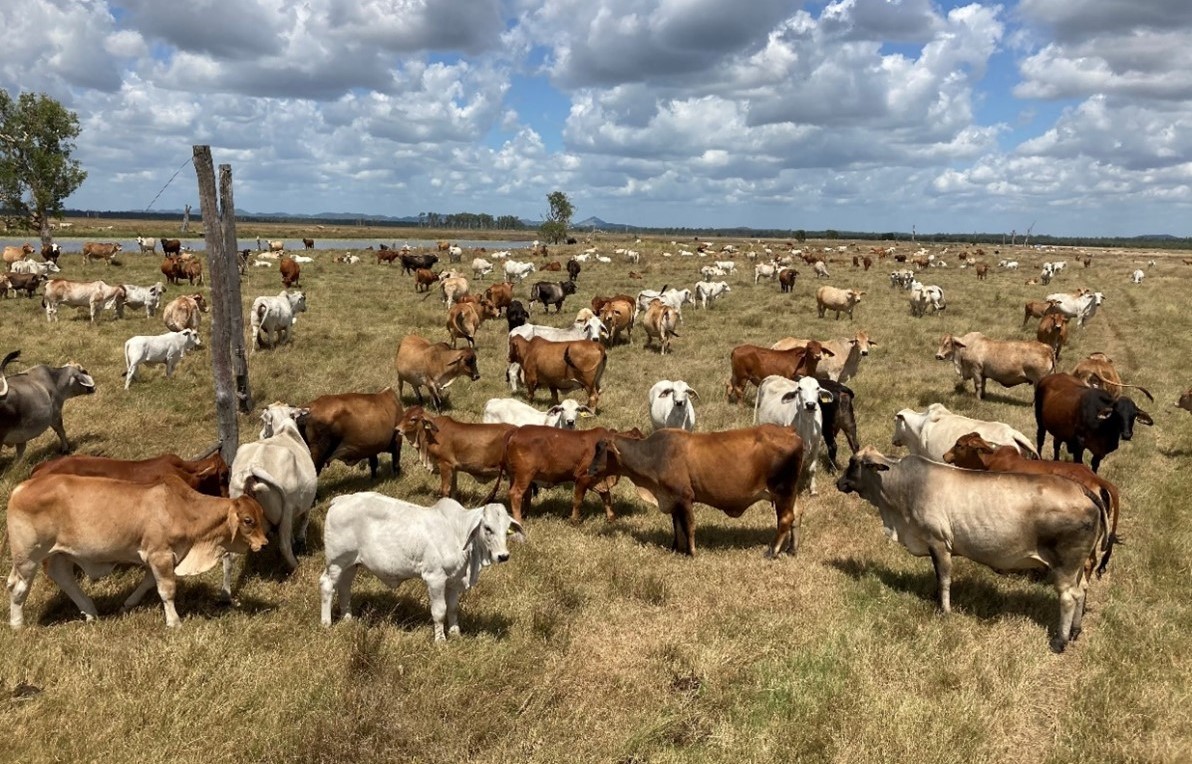
Ticking the boxes with paddock rotation
The Prices have also built onto the tick management program of the previous owners.
“We’ve implemented more paddock rotations with some new fences and have been treating cows with Acatak™. Our weaners have had injectable Dectomax™. Before the weaners can go to the Arcadia Valley they have to go through a clearing dip. We’re pleased to say that on inspection they were very clean — no ticks on the cattle from the paddocks where the paddock rotation has been implemented,” said Owen.
Implementing several practices in one year has been no mean feat for the Price family.
“We are really proud of the weaners that have come off Greenlake in our two rounds of weaning so far. The cattle look good, the cows are making milk and producing good weaners. It’s been hard work, but we are really proud of what we have achieved in one year.”
The Price family have a long history of working with the Department and have been great advocates for the beef extension service. They are currently participating in the Grazing Resilience and Sustainable Solutions and Northern Breeding Businesses projects and have been guest speakers and mentors in the Advancing Beef Leaders program.
“We are very appreciative of the relationship we have with the DAF team. We know we can give them a ring at any time and someone in the team will be able to answer our questions.”
Part 2 – 2025 life on Greenlake
August 2025 with Rob Price
The goal is the same, but the plan is flexible
The Price family still see the same role for Greenlake in their breeding, backgrounding and fattening operation, but some things look a little different.
“We are continuing to grow the breeder herd on Greenlake so we can supply weaners back to our western properties,” said Rob Price. “The rainfall here is reliable and as we fine-tune our management we can bank on having a certain number of weaners every year to send west.”
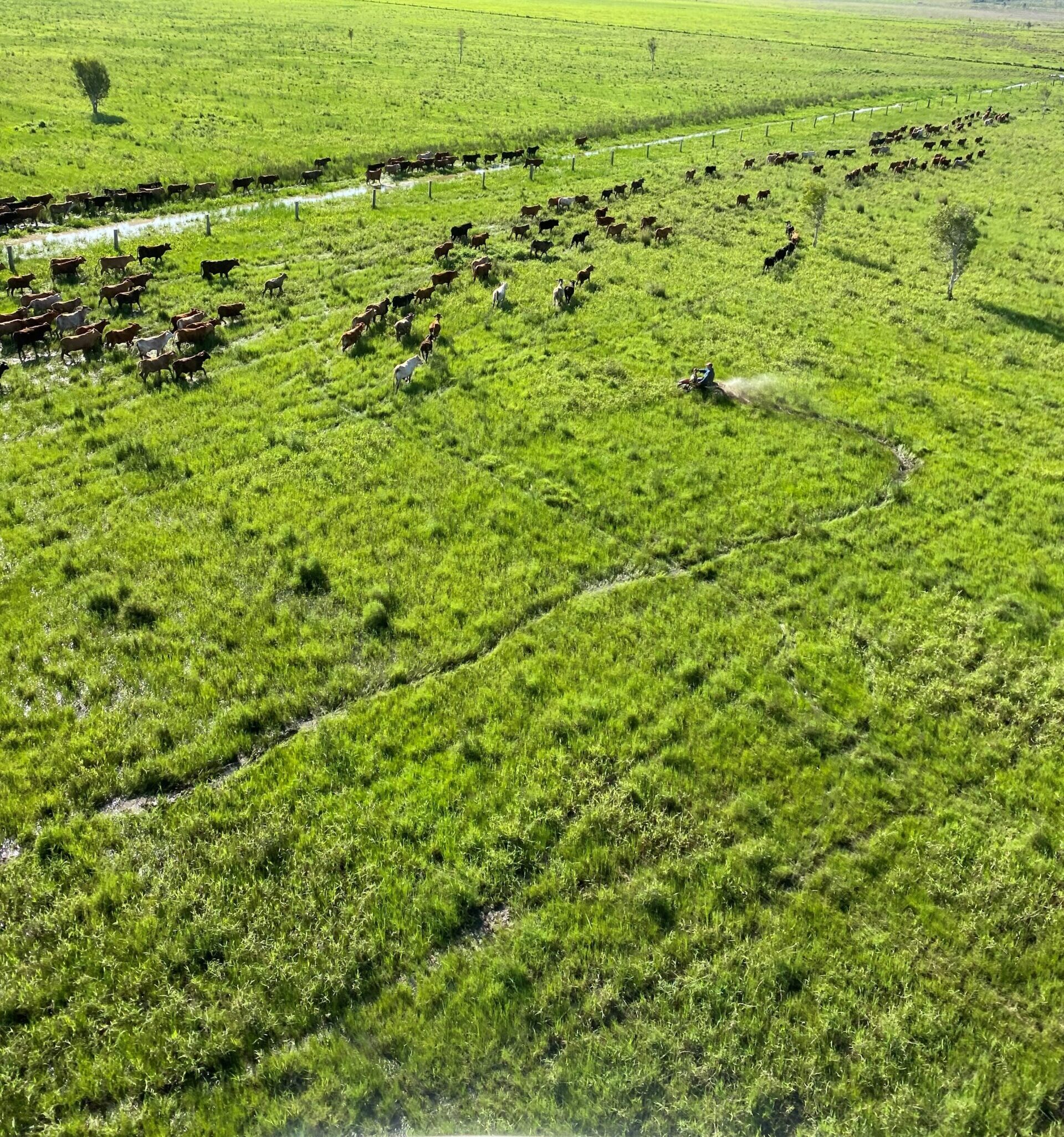
“Fertility is still a huge priority for our female herd so we have moved into Fullblood Wagyus, knowing that we can yearling mate them here on the coast and aim for a premium market with feeders after they background in the Valley or Mitchell.”
Wagyus were not originally in the plan for Greenlake but understanding market opportunities, growth cycles of pasture and the fertility of cattle across their properties, the Price family have demonstrated plans need to be flexible to achieve goals.
“We have successfully been calving here in winter like we always planned, and it has worked well with some of the big wet seasons and floods we’ve already had, just in these first few years. Winter calving also means we can move cull females west for backgrounding or fattening in Summer, when the season is best back there.”
A double-barrelled phosphorus approach – supplement and fertiliser
Phosphorus (P) is still a top priority on Greenlake with the supplementation program continuing year-round.
“We have modified the mix over the last few years and have now settled on something we are pretty happy with,” said Rob. “The mix is 8% phosphorus, 10% urea and the rest is copra and canola meal and little bit of sulphur. I keep track of the cattle consumption in AgriWebb [farm management platform] to make sure our lactating cows are eating about 10g of phosphorus a day. We have added some urea to the mix because on some areas of poorer wetter country, cattle really struggled with low protein in their diet.”
The results of the phosphorus supplementation speak for themselves.
“In our second year of weaning here, after we had been feeding phosphorus for 12 months, for our cattle in the northern more deficient country we spent $100 per weaner on P lick, but that gave us an extra 60kg of liveweight per weaner. We made that money back just in weaner weights alone. The cows were in better condition too, which helped with their re-conception rates.”
“Rob does a great job of providing feedback on the supplement mix and how cattle are doing on all of the country types on Greenlake,” said Kylie. “We know the cattle respond well to feeding P, but we were starting to get interested in how fertilising with P would impact lick consumption rates. We had a few chats with Rob and Owen and decided to do some trial strips of fertiliser to see what would happen over time.”
In late 2023 an area in a paddock with good grass and some legumes, was chosen for a fertiliser demonstration.
“We tested the soil in this paddock and it had less than 5 ppm of P, which is generally lower than what the lab can measure, so we knew the pasture would respond to fertiliser. We could see an adequate population of legumes in amongst the grass, but the paddock was mostly Signal grass with a bit of humidicola. We were interested to know how much P fertiliser we would need to apply to increase the pasture yield and the proportion of legumes. We know legumes really need P for good growth, and grass really needs the nitrogen that legumes provide. We wanted to fertilise the legumes to fertilise the grass to supplement the cattle,” said Kylie.
In December 2023 four test strips of fertiliser were applied and one strip left as a control. It rained the night the fertiliser was applied. In early 2024 a fence was put around half of the strips, so there could be a grazed and ungrazed comparison.
The fertilisers used were Di-ammonium phosphate (DAP) which is 20% P and 11% N and urea which is 46% N. The treatment strips were:
- 220 kg/ha urea
- 400 kg/ha DAP
- Nothing
- 200 kg/ha DAP
- 200 kg/ha DAP and 180 kg/ha urea
“I could see impact of the fertiliser strips within 10 days,” said Rob.
“I was flying over the paddock and we didn’t have it fenced yet. There were a handful of bulls in the paddock and they were all grazing strip 5 with the most fertiliser. I had planned to fertilise the rest of the paddock around the test strips but hadn’t got to it yet. After I saw it from the air that day, I was convinced. We slipped out and bought a couple of B doubles of DAP, then another couple (of B doubles) five months later. In total we have fertilised 1,080 hectares with 216 tonne of fertiliser.”
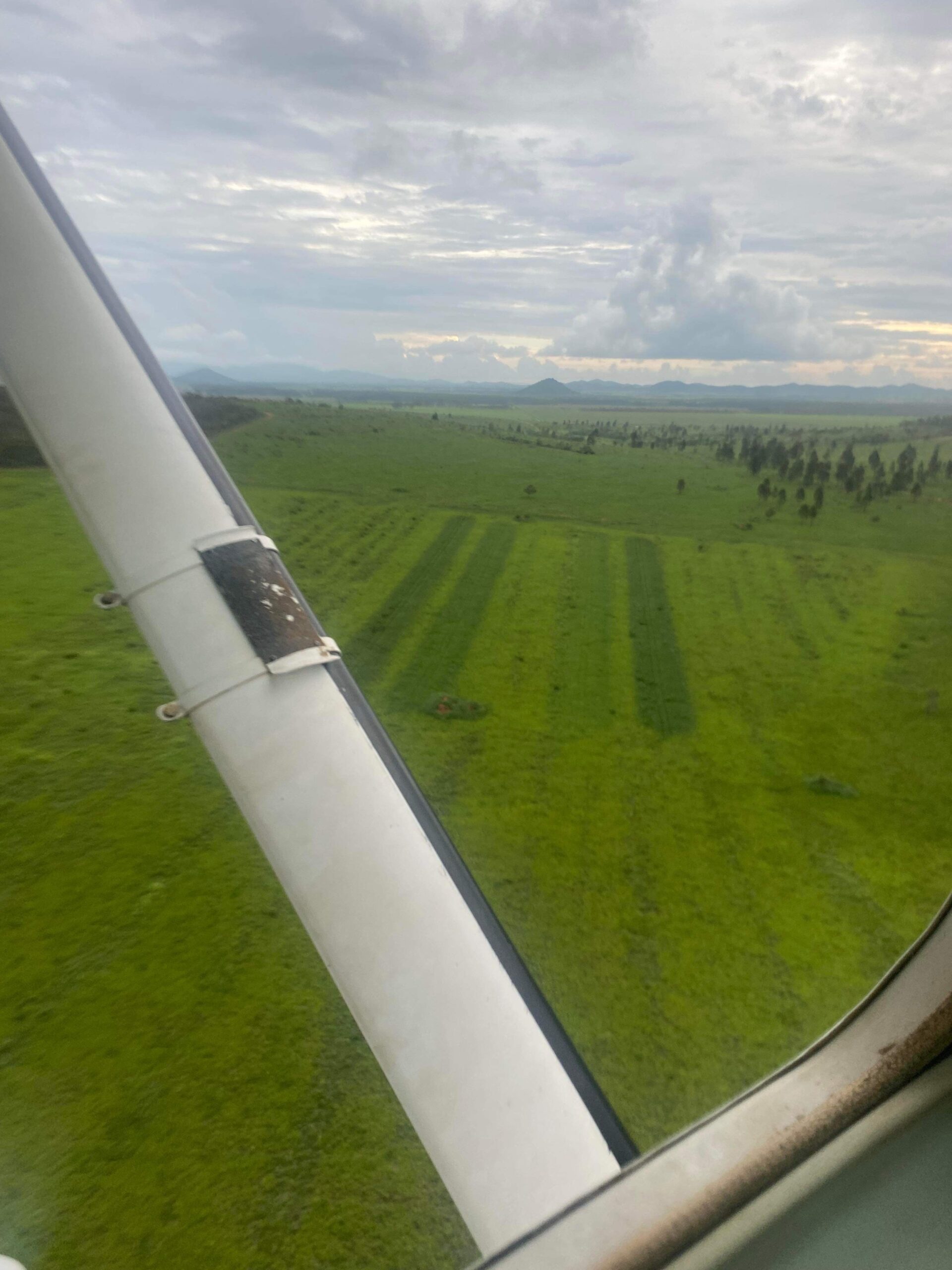
Rob has fertilised the ‘high country’ on Greenlake which is similar to the trial paddock – areas of low fertility, but with good grass cover, that are used to hold cattle when there is a flood.
“We need to make our high country more productive, so it can hold a higher stocking rate through the wet times,” commented Rob, “then we can use the flood plain in the dry. The fertiliser has already made our ridges more productive. When there is a flood and we have to move cattle to higher ground, we don’t know how long we will have to keep them there.”
“Cattle eat very little lick when they go into the fertilised country. If we can get five years out of this fertiliser, the savings of not having to put out that P lick will just about pay for the fertiliser.”
“The grass is also healthier. I was blown away this year – this house paddock here used to hold cattle for about 15 – 16 days. Then this year after fertilising, it got to 19 days and I could still hardly see where they had been. I moved them out and spelled it for 30 days and I could have easily put cattle back in again. The pasture production is so much better. Cattle behaviour is also totally different in the unfertilised paddocks. They’re mobbed up in a corner waiting to be moved out of a paddock, its like they can smell the fertiliser in the other paddocks!”
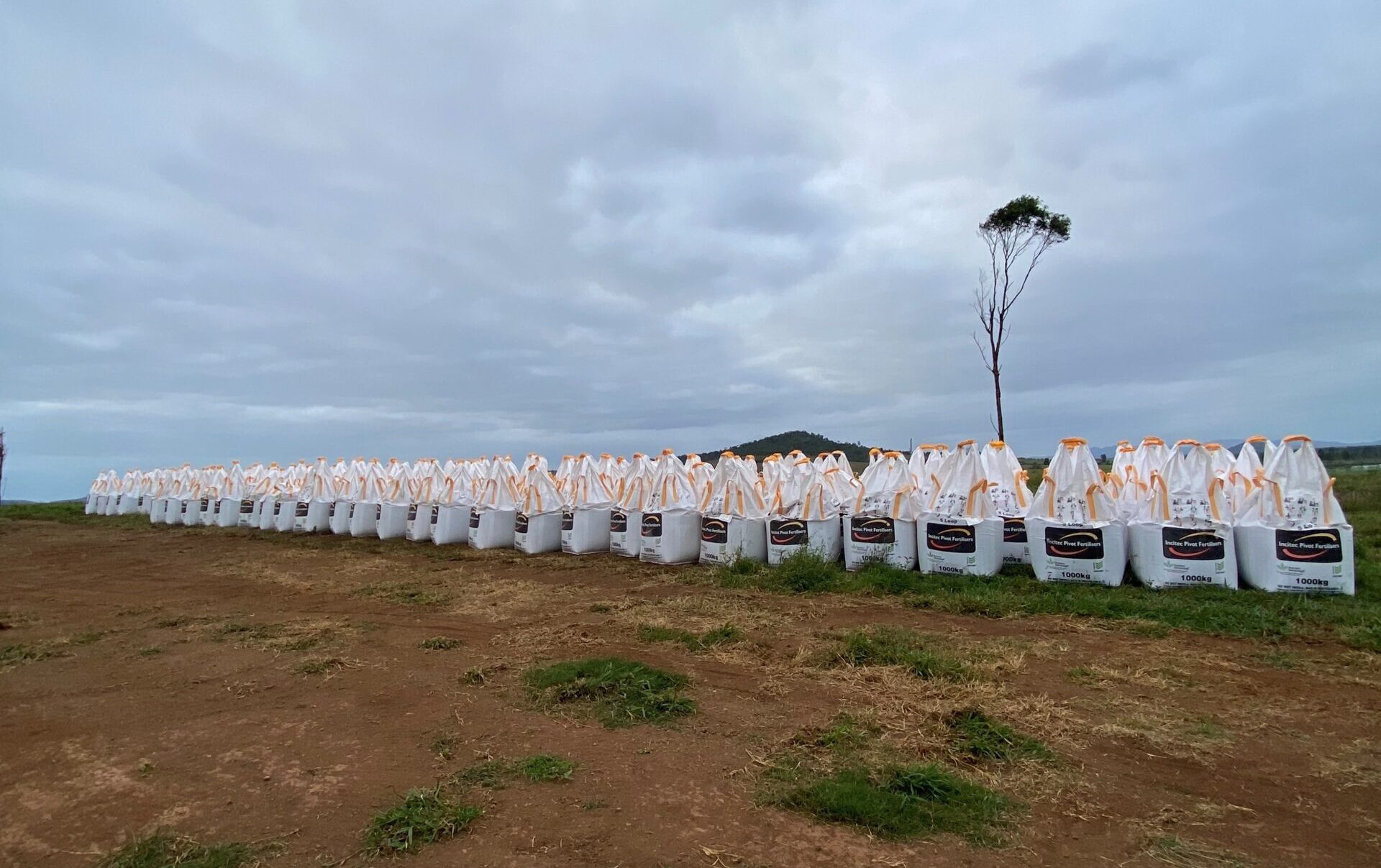
Kylie says the trial strips will be monitored for the next few years. “We are taking some measurements and observations to see if there are any differences between the treatments. In July 2024 we measured the pasture yield and all the fertiliser combinations were producing more dry matter than the control in the ungrazed area. The strips with urea were higher than those without, which is no surprise. We expect that the impact of the nitrogen will be gone in the first 12 months and the phosphorus will have a more prolonged impact. In the grazed area, it looks like the strips with urea are handling grazing a bit better as their yields are higher there too. But it is still early days, we’ll see what happens over the next few years.”
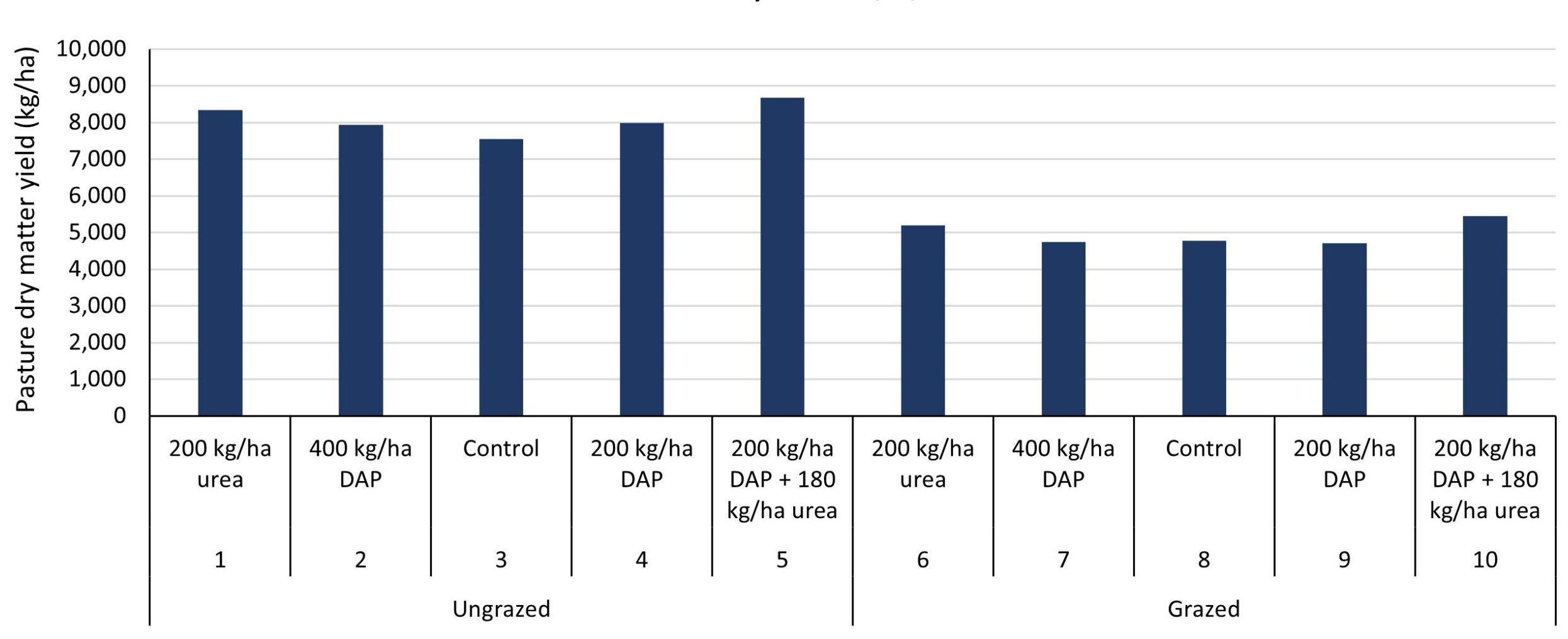
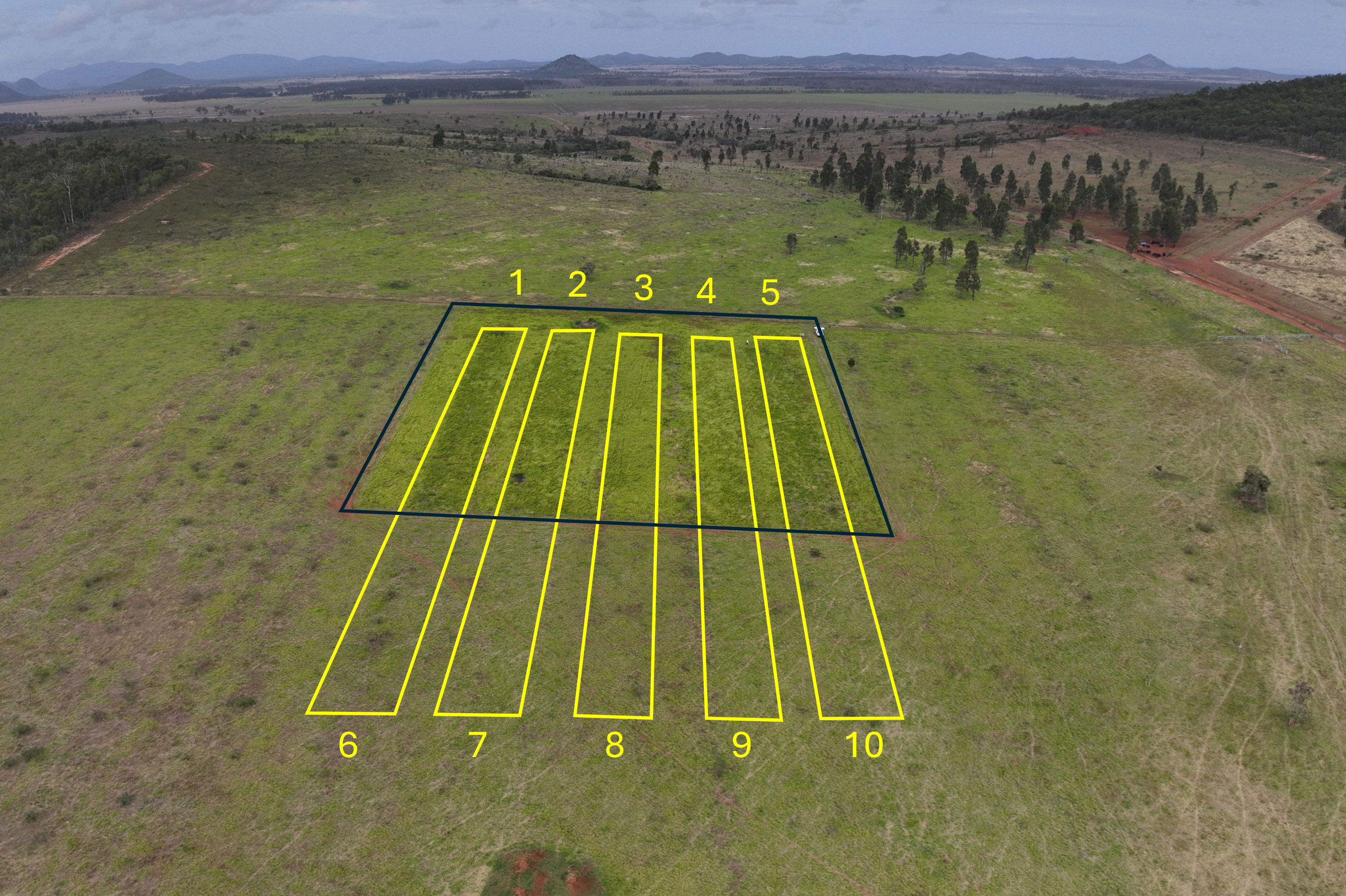
New pastures
Phosphorus fertiliser has had a large impact on pastures at Greenlake, but it wasn’t the only strategy to improve the productivity of the high country.
“Aside from fertilising, we have done lots of other pasture improvement,” said Rob.
“We have sprayed out or pelleted and stick raked some paddocks and re-seeded them before flying on the fertiliser. Because our rainfall here is so high, we’ve found we don’t need to go to the same effort to create a fine seed bed and fallow country before planting, like we have to do in the west. If we can time seeding right, we have lots of good follow up rain after germination.”
“We’ve planted lots more Signal grass, Mekong Brizantha and Rhodes grass in country that previously only had Indian couch. We have lots of legume in those paddocks, so we haven’t needed to sow legumes. The phosphorus fertiliser will boost them for us.”
Local networks and sharing with others
The Price family have openly talked about their learning process on the Coast.
“We have learned so much from people all around us,” said Rob. “The DPI team have always been there to answer our questions, but we’ve also found a wealth of knowledge in the local district. I have found mentors and friends in Lachy and Trudy Mace up at Stanage Bay, who have country like ours.”
“My sister Maddy lives here full time and in working together managing this place we have learnt so much and we are happy to share it with others, just like people have shared with us.”
The Price family hosted a property tour at Beef Australia in 2024 and openly shared their learning process and the changes they have implemented on Greenlake with about 100 people.
“It was really important to me to have Lachy and Trudy be a part of our property tour,” said Rob. “I couldn’t talk about what we do here without acknowledging the support I’ve received from them and I knew people at the property tour would learn lots from hearing them speak.”
“We are proud of what we have achieved at Greenlake, but everything is still a work in progress. It’s been a big learning curve but we are better land and cattle managers because of it. I am thankful to be working in a family business that takes on new challenges and gives me the opportunity to learn.”
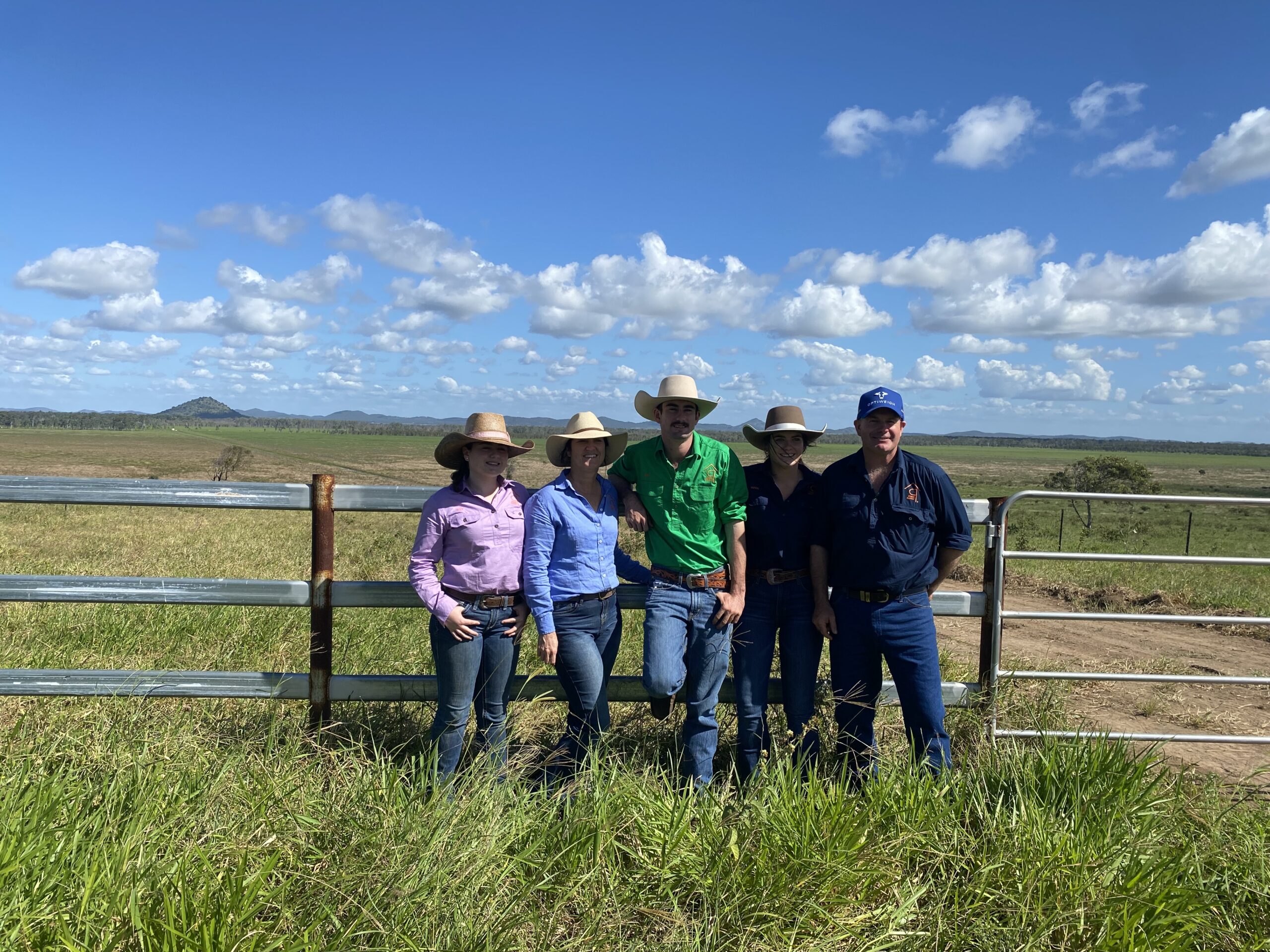
Putting a Price on a P deficiency
To hear more from Rob Price and Kylie Hopkins about what is happening at Greenlake, listen their episode of the FutureBeef podcast – Episode 9: Putting a Price on a P deficiency.
This work is funded by the Queensland Pasture Resilience Program which is a partnership between the Department of Primary Industries, Meat & Livestock Australia and the Australian Government through the MLA Donor Company.